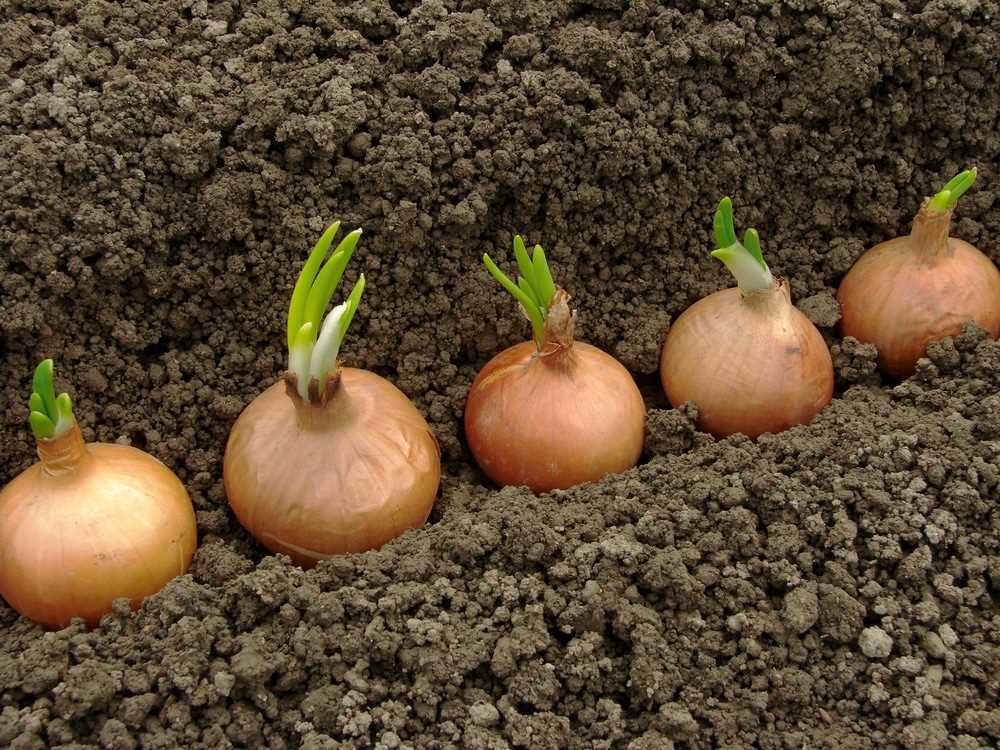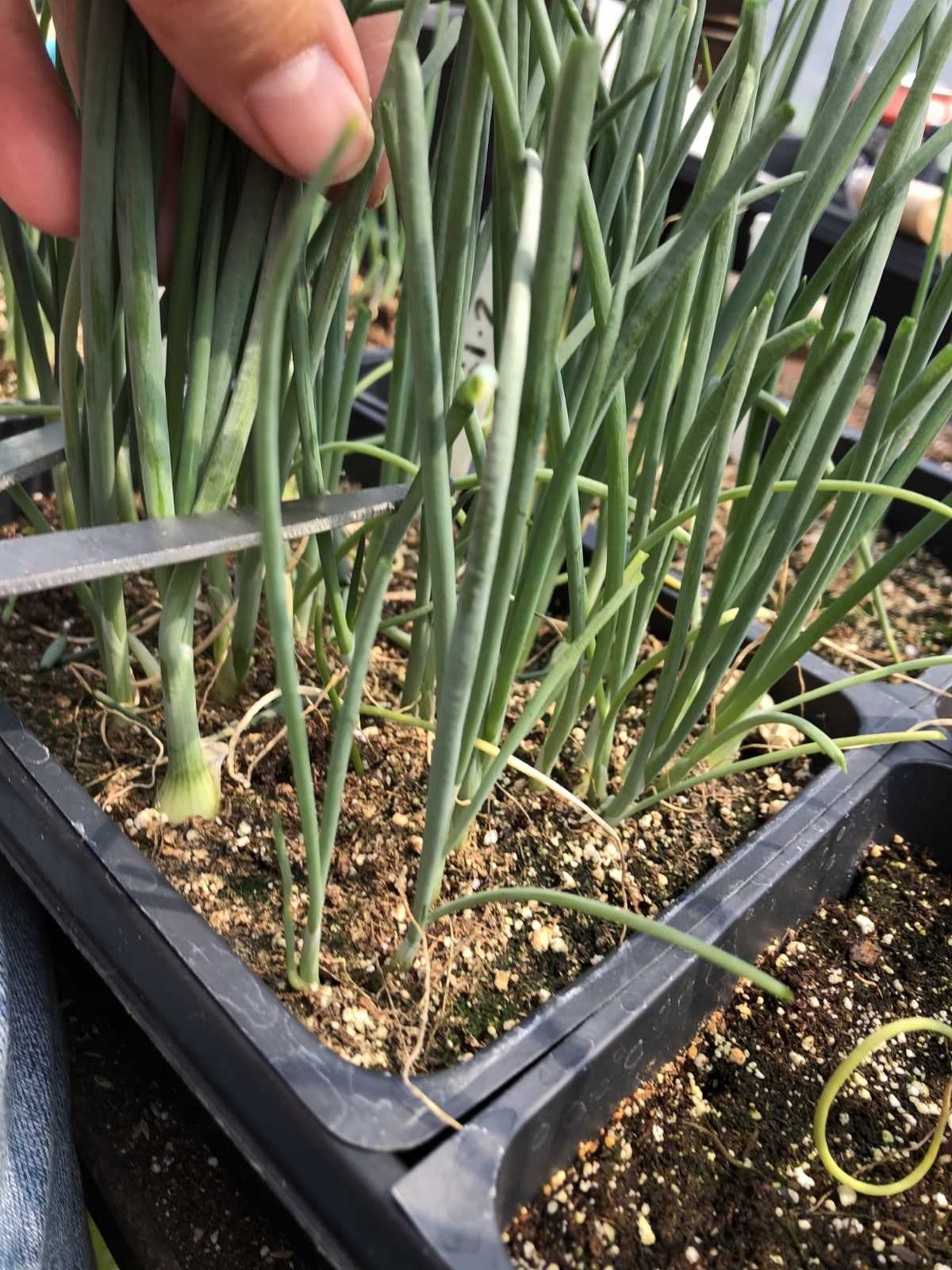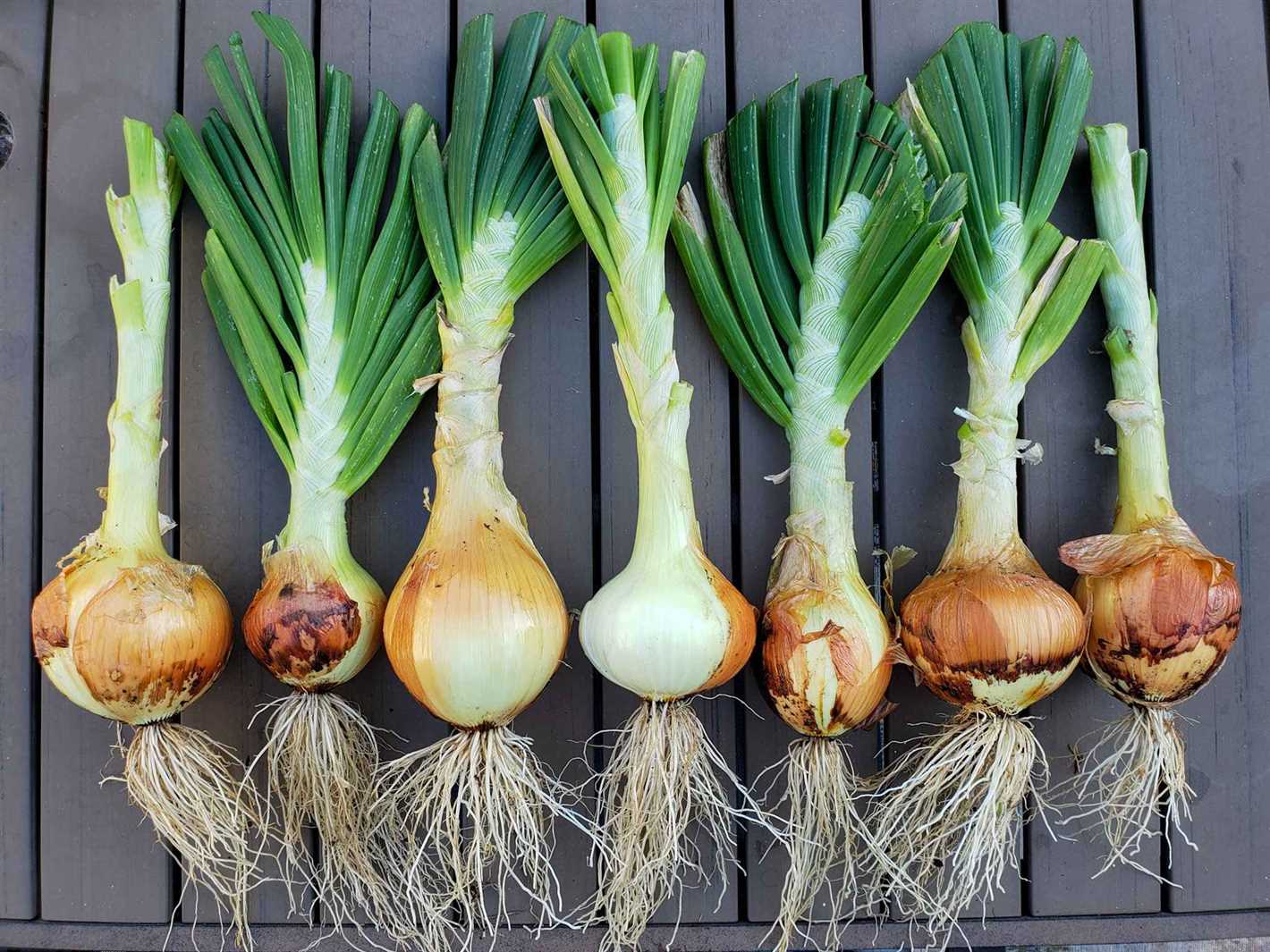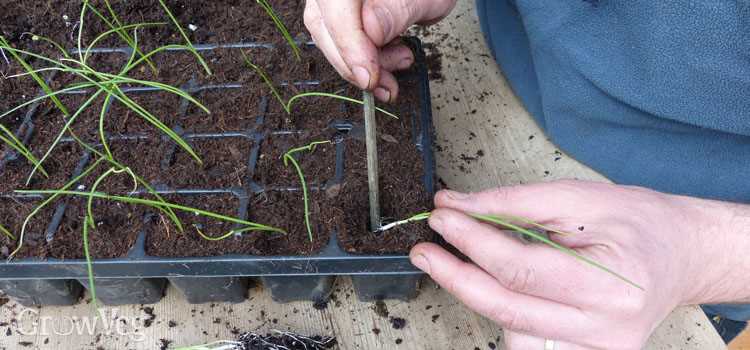- Importance of Onion Seedlings
- 1. Early Start
- 2. Strong and Healthy Plants
- 3. Weed Suppression
- 4. Uniform Growth
- 5. Higher Yields
- Causes of Dried Leaves on Onion Seedlings
- 1. Lack of moisture
- 2. Overwatering
- 3. Nutritional deficiencies
- 4. Environmental conditions
- 5. Pests and diseases
- 6. Transplant shock
- 7. Overcrowding
- Recognizing the Problem
- Adjusting Watering Practices
- 1. Watering Frequency
- 2. Watering Technique
- 3. Soil Moisture Level
- 4. Mulching
- 5. Water Quality
- Providing Adequate Sunlight
- Sunlight Requirements for Onion Seedlings
- Supplementing with Grow Lights
- Protecting Seedlings from Excessive Sunlight
- Proper Nutrient Supply
- Avoiding Overcrowding
- Additional Tips for Healthy Onion Seedlings
- 1. Mulching
- 2. Proper Watering Technique
- 3. Thin Seedlings
- 4. Provide Adequate Sunlight
- 5. Fertilize As Needed
- 6. Protect from Pests
- 7. Harden Off Seedlings
- 8. Monitor Temperature
- 9. Regularly Inspect for Disease
- 10. Rotate Crops
- “Question-Answer”
- Why are the leaves on my onion seedlings drying out?
- What can I do to prevent the leaves of my onion seedlings from drying out?
- Can I still save my onion seedlings with dried leaves?
- What nutrients do onion seedlings need to prevent leaf drying?
- Should I remove the dried leaves from my onion seedlings?
- “Video” why plant leaves turn brown and dry on the ends
Growing onions from seedlings can be a rewarding experience, but it comes with its own set of challenges. One common issue that many gardeners face is dried leaves on onion seedlings. This can be a sign of nutrient deficiency or improper care. However, with the right feeding tips, you can revive your onion seedlings and help them thrive.
One of the main reasons for dried leaves on onion seedlings is a lack of water. Onions have shallow roots, so they need a consistent supply of moisture. Make sure you are watering your seedlings regularly, keeping the soil evenly moist but not soggy. It’s important to note that overwatering can also lead to dried leaves, so finding the right balance is key.
In addition to proper watering, providing adequate nutrients is crucial for the health of your onion seedlings. Onions are heavy feeders and require a balanced fertilizer that is high in nitrogen. Look for a fertilizer with a higher nitrogen content, such as a 10-10-10 or 20-20-20 blend. Apply the fertilizer according to the package instructions, taking care not to overfeed as this can cause leaf burn.
Another feeding tip to consider is mulching around your onion seedlings. Mulch helps to retain moisture in the soil, preventing the roots from drying out. It also helps to suppress weeds, which can compete with your onions for nutrients. Apply a layer of organic mulch, such as straw or grass clippings, around the base of your seedlings, being cautious not to cover the foliage.
By following these feeding tips and providing your onion seedlings with proper care, you can prevent and address dried leaves. Remember to water consistently, provide adequate nutrients, and mulch to maintain moisture levels. With a little TLC, your onion seedlings will soon thrive, and you’ll be rewarded with a bountiful harvest.
Importance of Onion Seedlings

Onion seedlings play a critical role in the success of any onion crop. These small, delicate plants are the initial stages of onion growth and serve as the foundation for a healthy and productive harvest. It is important to give proper attention and care to these seedlings to ensure their optimal growth and development.
1. Early Start
Starting onion seedlings early allows them to establish a strong root system before transplanting them into the garden. This gives the seedlings a head start and helps them adapt better to the outdoor conditions. It also enables the plants to have a longer growing season, resulting in larger bulbs.
2. Strong and Healthy Plants
Onion seedlings need proper nutrition and care to develop into strong and healthy plants. Providing them with the right nutrients, such as nitrogen, phosphorous, and potassium, through a well-balanced fertilizer ensures their growth and vigor. Additionally, ensuring they receive adequate water and are protected from pests and diseases is essential for their overall health.
3. Weed Suppression
Established onion seedlings create a dense cover on the soil surface, reducing the space available for weeds to grow. This natural weed suppression helps maintain a clean and weed-free vegetable garden, reducing competition for resources and ensuring the onion plants have optimal access to sunlight, water, and nutrients.
4. Uniform Growth

Proper care and attention to onion seedlings result in uniform growth and development. This is crucial for onion crops as it allows for consistent bulb formation and ensures even ripening. Planting uniform seedlings also simplifies the harvesting process, as all the plants will be ready for harvesting at the same time.
5. Higher Yields
Healthy and well-developed onion seedlings contribute to higher yields. These seedlings have a better chance of producing large and robust bulbs, which are desired for culinary purposes. By dedicating time and effort to the care of onion seedlings, growers can maximize their crop’s productivity and profitability.
<
Causes of Dried Leaves on Onion Seedlings
Dried leaves on onion seedlings can be caused by a variety of factors. Understanding these factors can help you diagnose and address the problem effectively.
1. Lack of moisture
One common cause of dried leaves on onion seedlings is a lack of moisture. Onions require consistent moisture to grow properly, and if they do not receive enough water, their leaves can dry out and become crispy. Ensure that the soil is adequately moist but not waterlogged.
2. Overwatering
On the other hand, overwatering can also lead to dried leaves on onion seedlings. Too much water can suffocate the roots and cause them to rot, resulting in the drying out of leaves. It is essential to find the right balance and only water the plants when the top inch of soil feels dry.
3. Nutritional deficiencies
Poor soil conditions or nutrient deficiencies can also contribute to dried leaves on onion seedlings. Onions require a balanced mix of nutrients, particularly nitrogen, phosphorus, and potassium, for healthy leaf growth. Insufficient levels of these nutrients can cause the leaves to dry out. Consider adding compost or fertilizers to improve soil fertility.
4. Environmental conditions
Onion seedlings can be sensitive to environmental conditions. Exposure to extreme temperatures, including heat or cold, can stress the plants and result in dried leaves. Additionally, excessive sun exposure without proper shade can lead to dehydration and leaf damage. Provide shade or relocate the seedlings if necessary.
5. Pests and diseases
Pests and diseases can also cause dried leaves on onion seedlings. Common pests such as onion thrips or diseases like fungal infections can damage the leaves and cause them to dry out. Regularly inspect the seedlings for any signs of pest infestation or disease, and take appropriate measures to control them.
6. Transplant shock
Transplanting onion seedlings can sometimes result in dried leaves due to transplant shock. Moving the seedlings from their original pots or trays to the garden can stress the plants, leading to leaf wilting or drying. Gradually acclimate the seedlings to the outdoor conditions before transplanting to minimize shock.
7. Overcrowding
If onion seedlings are overcrowded, they may not have sufficient space and resources to grow properly. Lack of airflow and competition for nutrients can cause the leaves to dry out. Ensure adequate spacing between plants during planting to prevent overcrowding and promote healthy leaf growth.
By understanding and addressing these potential causes, you can help ensure the health and vitality of your onion seedlings, preventing dried leaves and promoting proper growth and development.
Recognizing the Problem

When caring for onion seedlings, it is important to be able to recognize and address any issues that arise. One common problem is dried leaves on the seedlings. These dried leaves can be a sign of underlying issues that need to be addressed in order to ensure the health and growth of the plants.
There are several factors that can lead to dried leaves on onion seedlings. One possibility is underwatering. If the seedlings are not receiving enough water, their leaves can dry out and become crispy. On the other hand, overwatering can also cause dried leaves. When onion seedlings sit in overly wet soil for a prolonged period, their roots can rot, leading to the drying out of the leaves.
In addition to watering issues, poor soil quality can also contribute to dried leaves. If the soil lacks proper nutrients or has a high salt content, it can deprive the seedlings of necessary nutrients, causing the leaves to dry out.
Lastly, environmental factors such as excessive heat or cold can also cause dried leaves on onion seedlings. Extreme temperatures can stress the plants and lead to leaf damage.
By understanding the potential causes of dried leaves on onion seedlings, you can take steps to address the underlying issues and ensure the health and vitality of your plants. In the next section, we will discuss some feeding tips to help combat this problem.
Adjusting Watering Practices
The health of onion seedlings can be greatly influenced by the amount and frequency of watering. Proper watering practices can help prevent the leaves from drying out and ensure the overall health and growth of the plants.
1. Watering Frequency
Onion seedlings require regular but not excessive watering. It is important to maintain moist soil conditions without causing waterlogged roots. Water the seedlings whenever the top inch of soil feels dry to the touch. This may require watering them every 2-3 days, but it can vary depending on environmental factors such as temperature and humidity.
2. Watering Technique
When watering onion seedlings, it is advisable to use a gentle watering technique to prevent damage and ensure even distribution of water. Use a watering can or a hose with a mist nozzle attachment to provide a gentle shower of water. Avoid using high-pressure sprays that can dislodge the seedlings or cause soil erosion.
3. Soil Moisture Level
Regularly monitor the moisture level of the soil to prevent over or under-watering. Insert your finger about an inch into the soil, if it feels dry, it’s time to water. However, if it feels too wet or waterlogged, reduce watering frequency or adjust drainage to improve soil conditions.
4. Mulching
Applying a layer of organic mulch around the onion seedlings can help retain moisture in the soil and prevent excessive evaporation. Mulching also helps to regulate soil temperature and suppress weed growth. Use materials such as straw, wood chips, or dried leaves as mulch, and apply it around the base of the seedlings, leaving a small space near the stems to prevent rot.
5. Water Quality
The quality of water used for watering can also affect the health of the onion seedlings. Ideally, use water that is free from chemicals, such as chlorine, which can be harmful to the plants. If tap water is used, let it sit for 24 hours before watering to allow any chlorine to evaporate.
By adjusting your watering practices and providing the proper amount of moisture, you can help prevent the leaves of onion seedlings from drying out and promote healthy growth.
Providing Adequate Sunlight
One essential factor for the health and growth of onion seedlings is ensuring they receive adequate sunlight. Sunlight provides the energy needed for photosynthesis, the process by which plants convert light into usable energy.
When seedlings receive insufficient sunlight, they may become weak and leggy, with long stems and sparse foliage. This can lead to a lack of vigor and poor overall growth.
Sunlight Requirements for Onion Seedlings
Onion seedlings require at least 12-16 hours of direct sunlight each day to thrive. If you are growing them indoors or in a greenhouse, place them in a location that receives maximum sunlight exposure throughout the day.
If you are growing onion seedlings outdoors, choose a sunny spot in your garden with minimum shade from trees or other structures. Ensure that the location offers full sun exposure for most of the day.
Supplementing with Grow Lights
In situations where natural sunlight is inadequate or not available, you can supplement with artificial grow lights. Grow lights provide the necessary spectrum of light to support plant growth.
When using grow lights, position them about 4-6 inches above the onion seedlings and keep them on for 12-16 hours each day, mimicking natural sunlight conditions.
Protecting Seedlings from Excessive Sunlight
While onion seedlings require ample sunlight, it’s also crucial to protect them from excessive sunlight and heat. Too much direct sunlight can cause sunburn, wilting, or scorching of the delicate seedlings.
To protect the seedlings, provide partial shade during hot hours of the day, especially during the peak summer months. You can use shade cloth or lightweight fabric to create shade or move the seedlings to a shaded area temporarily.
Regularly monitor the seedlings for any signs of sun damage, such as yellowing or brown spots on the leaves or wilting. If you observe any damage, adjust the shading accordingly.
By ensuring onion seedlings receive adequate sunlight and protecting them from excessive exposure, you can encourage healthy growth and development, resulting in robust onion plants.
Proper Nutrient Supply
One of the main reasons why onion seedlings may develop dried leaves is due to improper nutrient supply. It is essential to provide the seedlings with the necessary nutrients to promote healthy and vigorous growth.
1. Nitrogen-rich fertilizer: Nitrogen is an essential nutrient for plant growth, especially during the early stages. Choose a fertilizer specifically formulated for seedlings or one with a high nitrogen content. Apply the fertilizer according to the manufacturer’s instructions, ensuring that it is evenly distributed around the seedlings.
2. Phosphorus and potassium: In addition to nitrogen, onion seedlings require adequate amounts of phosphorus and potassium. These nutrients promote root development, disease resistance, and overall plant vigor. Look for a balanced fertilizer with phosphorus and potassium included. Apply it following the instructions on the packaging.
3. Organic matter: Incorporating organic matter into the soil before planting onion seedlings can help improve nutrient availability and overall soil health. Compost, well-rotted manure, or other organic materials can be added to enrich the soil. Mix them thoroughly into the top few inches of soil to provide a nutrient-rich environment for the seedlings.
4. Mulching: Applying a layer of organic mulch around the base of the seedlings can help retain moisture, regulate soil temperature, and provide a slow-release source of nutrients. Use materials such as straw, shredded leaves, or grass clippings for mulching. Apply a layer about 2-3 inches thick, ensuring that the mulch does not touch the onion stems directly.
5. Regular watering: Proper watering is crucial for nutrient uptake by onion seedlings. Under-watering can lead to nutrient deficiencies, while over-watering can cause root rot and other problems. Water the plants deeply and consistently, allowing the soil to dry slightly between waterings. Avoid waterlogging, as it can deprive the roots of oxygen and lead to stunted growth.
6. Foliar feeding: If the onion seedlings continue to show signs of nutrient deficiency even after proper fertilization and watering, foliar feeding can be beneficial. Dilute a balanced liquid fertilizer in water and spray it directly onto the leaves. This method allows for quick nutrient absorption and can help in correcting deficiencies.
7. Regular soil testing: Regular soil testing can provide valuable insights into the nutrient composition of the soil and help identify any deficiencies or imbalances. Conduct soil tests before planting, and periodically thereafter, to determine the nutrient requirements of the onion seedlings. Based on the results, adjust your fertilizer application and nutrient management practices accordingly.
By ensuring a proper nutrient supply, onion seedlings can develop healthy and vibrant leaves, significantly reducing the incidence of dried leaves and promoting overall plant growth.
Avoiding Overcrowding
One common mistake that can lead to dried leaves on onion seedlings is overcrowding. When onion seedlings are planted too close together, they have to compete for resources such as water, nutrients, and sunlight. This can result in stunted growth and dried leaves.
To avoid overcrowding, make sure to give each onion seedling enough space to grow. When planting the seedlings, place them about 4-6 inches apart in rows that are spaced at least 12-18 inches apart. This will give each seedling enough room to spread out and receive the necessary resources.
It’s also important to thin out the seedlings if they become too crowded. Once the seedlings have grown to about 4-6 inches tall, carefully remove some of the weaker seedlings, leaving only the strongest plants in each row. This will help ensure that each seedling has enough space and resources to grow properly.
In addition to preventing overcrowding, it’s important to provide proper care for the onion seedlings. This includes watering them regularly, providing adequate sunlight, and fertilizing them appropriately. By following these tips, you can help prevent dried leaves and promote healthy growth in your onion seedlings.
Additional Tips for Healthy Onion Seedlings
1. Mulching
Applying a layer of mulch around your onion seedlings can help retain moisture in the soil and prevent weed growth. Organic mulches, such as straw or grass clippings, can also add nutrients to the soil as they break down.
2. Proper Watering Technique
Water your onion seedlings deeply and evenly, making sure that the soil is moist but not waterlogged. Avoid overwatering, as this can lead to root rot and other diseases. Check the moisture level by sticking your finger into the soil – if it feels dry up to your first knuckle, it’s time to water.
3. Thin Seedlings
If your onion seedlings are growing too close together, it’s important to thin them out. Overcrowding can lead to competition for resources and stunted growth. Gently pull out the weaker seedlings, leaving only the healthiest ones to grow.
4. Provide Adequate Sunlight
Onion seedlings require at least 6 hours of direct sunlight per day for healthy growth. Make sure to place them in a sunny spot or use artificial grow lights to supplement natural sunlight. Insufficient sunlight can result in weak, leggy plants.
5. Fertilize As Needed

If your onion seedlings are showing signs of nutrient deficiency, such as yellowing leaves, you may need to provide supplemental fertilizer. Use a balanced fertilizer with equal amounts of nitrogen, phosphorus, and potassium. Follow the manufacturer’s instructions for application rates.
6. Protect from Pests
Keep an eye out for pests that may damage your onion seedlings, such as aphids, onion maggots, or thrips. If you notice any signs of infestation, treat the plants with organic insecticides or insecticidal soap.
7. Harden Off Seedlings
Prior to transplanting your onion seedlings into the garden, it’s important to harden them off. This process involves gradually exposing the seedlings to outdoor conditions, such as wind and direct sunlight, for a few hours each day. Start with short periods of exposure and gradually increase the time over the course of a week.
8. Monitor Temperature
Onion seedlings prefer cooler temperatures and do not tolerate frost. Keep an eye on the weather forecast and protect your seedlings from extreme temperatures. If frost is expected, cover them with a row cover or bring them indoors overnight.
9. Regularly Inspect for Disease
Regularly inspect your onion seedlings for signs of disease, such as wilting, unusual discoloration, or spots. If you notice any symptoms, promptly remove and destroy the infected plants to prevent the spread of disease.
10. Rotate Crops
Avoid planting onions in the same spot year after year, as this can lead to a buildup of soil-borne diseases and pests. Instead, practice crop rotation by planting onions in a different area of the garden each year. This helps maintain soil health and reduces the risk of disease.
“Question-Answer”
Why are the leaves on my onion seedlings drying out?
The leaves on onion seedlings can dry out due to several reasons, including underwatering, overwatering, lack of nutrients, or disease. It’s important to identify the specific cause in order to address the issue properly.
What can I do to prevent the leaves of my onion seedlings from drying out?
To prevent the leaves of onion seedlings from drying out, make sure you provide them with adequate water, but avoid overwatering. Additionally, ensure that your seedlings receive enough sunlight and are planted in well-draining soil. Regularly feeding them with a balanced fertilizer can also help prevent leaf drying.
Can I still save my onion seedlings with dried leaves?
In some cases, it is possible to save onion seedlings with dried leaves. First, identify and address the underlying issue that is causing the drying. Then, carefully trim off the dried leaves without damaging the healthy ones. Finally, provide the seedlings with proper care, including adequate water, nutrients, and sunlight, to encourage new growth.
What nutrients do onion seedlings need to prevent leaf drying?
Onion seedlings require a balanced mix of nutrients to prevent leaf drying. They need nitrogen for green leafy growth, phosphorus for root development, and potassium for overall plant health. Using a fertilizer specifically formulated for seedlings can provide them with the necessary nutrients.
Should I remove the dried leaves from my onion seedlings?
Yes, it is recommended to remove the dried leaves from onion seedlings. These leaves are no longer providing any benefits to the plant and may even attract pests or diseases. By carefully trimming off the dried leaves, you can help the seedlings allocate their resources to healthy growth.







